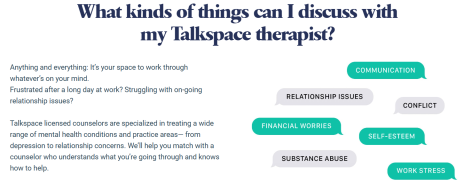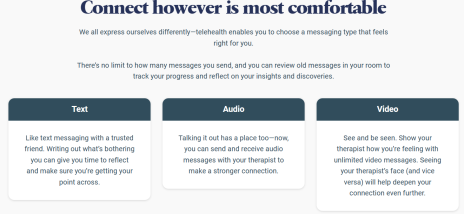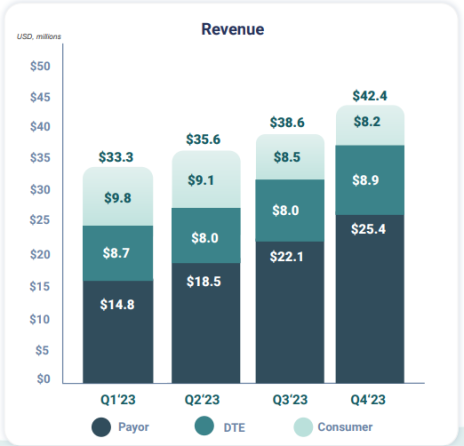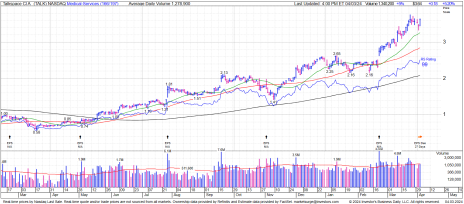The Big Idea
The experts say the U.S. is facing a behavioral health crisis.
Maybe it was the pandemic. Maybe it’s TikTok, X and Facebook (META).
Did you know the data shows kids are spending about five hours a day on social media? That’s just plain crazy. Especially when you consider just how important popularity is with the youngsters.
There’s also data showing roughly a third of adults report symptoms of anxiety or depression.
Not cool.
Oh yeah, let’s not forget that the number of people over 65 with mental health challenges has more than doubled since 2020, with roughly a quarter of seniors saying they have significant loneliness and/or depression.
What the?!
There’s more. When you go down the mental health crisis rabbit hole it gets pretty dark.
Forbes reported that in 2023, 42% of U.S. adults with a diagnosable condition said they could not afford to access the treatment they needed.
So not only are they struggling, they can’t seem to find help.
One of the seemingly easy solutions to this crisis is to get help online, with a virtual behavioral health provider.
That’s exactly the kind of company we’re jumping into today.
This company offers affordable and accessible therapy. It has over 5,000 qualified therapists that patients can access from wherever and whenever.
They typically get matched with a therapist in just a day or two, can get treated for over 120 conditions and can connect via video, text or just a plain old phone call.
Even better, an increasing number of people – 131 million at last count, to be exact – can get therapy through this platform paid for by their employer, Medicare, or a sponsoring organization, like the city of New York.
This is especially helpful for teens and seniors, two demographics where the mental health crisis seems to be growing.
Not only is the service important, but the company is growing revenue north of 20% and will turn the corner to profitability early in 2024.
It’s also tiny, with a share price well under 5.00.
The Company
Talkspace (TALK) is a virtual behavioral health company that offers members convenient and affordable access to a fully credentialed network of qualified, licensed therapists, psychologists and psychiatrists.
The company was founded in 2012 and has a market cap of just under $590 million.
The platform is available across all 50 states and covers over 20 specializations. Teens are one of the fastest-growing demographics to use Talkspace, and a recent approval for Medicare opens the door to people over 65.
The benefits of the platform for members are fairly obvious. It’s accessible anytime and anywhere. Costs are relatively low, sometimes costing nothing (thanks to insurance).
For providers, Talkspace is attractive because it offers flexibility, convenience, growth opportunities and efficiency. The company handles a lot of the back-office operations so providers can focus on doing what they do best. Providers are a mix of employees and independent contractors.
Perhaps one of the best indicators of the platform’s growing popularity is the growth of completed sessions with Talkspace’s biggest client group, those covered by insurance providers.
Last year (2023) these members completed 850,600 sessions, roughly double the number from 2022.
The Talkspace Platform
At a high level, there are six steps to a member’s journey when using the Talkspace platform.
First is a screening/intake process, which is followed by matching a therapist with the inquiring patient (a machine-learning tool helps with this). Then comes treatment, followed by measurement of outcomes, the discharge process and finally ongoing maintenance sessions, as needed.
One of the biggest challenges with any therapy, and the same goes for virtual care, is keeping patients engaged long enough to benefit.
One of the key benefits of Talkspace’s platform (aside from convenient access to therapists) is that data is collected throughout the patient’s journey to help providers deliver effective treatment and, hopefully, keep patients coming back.
When it comes to communications, everything is handled through messaging, video and audio. Every Talkspace user has a secure, private “room” to communicate with their therapist. They can send messages 24/7, though obviously, most therapists won’t answer at crazy times in the middle of the night.
There are two types of therapy available through Talkspace: psychotherapy and psychiatry.
Psychotherapy: A.K.A. “talk therapy.” Psychotherapy sessions revolve around treating specific mental health conditions such as depression, anxiety, trauma, etc., and developing positive thinking and coping skills.
Psychiatry: Psychiatry services focus on personalized, expert care from board-certified psychiatrists and/or prescription-eligible nurse practitioners who specialize in mental health care and prescription management. A typical package includes an initial video consultation followed by as-needed video appointments. If a patient requires a “controlled substance,” which is overseen by the federal Controlled Substances Act, they need to advance to a face-to-face provider.
As of the end of 2023, Talkspace had 131 million “eligible lives” (+42% over 2022). Users fall into three groups/business segments.
The smallest group is the Direct-to-Enterprise (DTE) segment, which made up 22% of 2023 revenue. This includes large companies, organizations, school districts, etc., including examples such as Alphabet (GOOG), the New York City Dept. of Health and Mental Hygiene and LendingTree (TREE).
While the DTE segment was the smallest last year (except for Q4), it’s also been an area of renewed investment and should post significant growth in the years ahead (see chart below).
The second group is the Consumer segment. These are individual subscribers who pay for their own therapy sessions. This group made up 24% of 2023 revenue. Member count shrunk by 3,700 (24%) in 2023, to 11,700.
The largest group is the Payor segment, which includes members who get access to the platform at in-network reimbursement rates. These customers include Aetna, Cigna (CI) and Optum, and made up 54% of revenue last year.
This chart of quarterly revenue by segment shows the trend.
Not surprisingly, the company believes stable growth will mainly come from repeat users who have therapy sessions either fully or partially paid for by insurance or their employer. This is why management has been investing in the Enterprise channel.
Growth Initiatives
Grow Covered Lives: Covered lives grew by 42% in 2023 (from 92 million to 131 million). This is the biggest driver of Talkspace’s growth as it sets the size of the market of potential customers that it can engage with its platform.
Grow Enterprise Channel, Including Teens: Talkspace has rebuilt its Enterprise sales team, which has been very active adding covered lives with school districts, cities, states and counties. Just a few recent partnerships include the city of New York ($26 million contract with 465,000 teenagers), the Baltimore County school system (32,000 lives), the state of Vermont and the American Federation of Teachers (1.7 million lives). Expect more partnerships, especially with teen groups, in 2024.
Medicare: In 2023 Talkspace became a Medicare and Medicare Advantage provider, which adds 65 million covered lives. The company will roll out its platform to all 50 states throughout 2024. Suffice to say, this could be a big one. The company “just” needs to make sure it addresses the needs of the Medicare population.
A.I.-Powered Product Improvements: Talkspace has built A.I. tools into its platform that can detect patient language patterns consistent with individuals at risk for self-harm or suicide (83% accurate) and which can generate both patient intake summaries as well as session summaries, both of which are very helpful for therapists. This isn’t an “A.I. stock,” but there are certainly more opportunities for the technology to help Talkspace improve products and create operational efficiencies.
The Business Model
Talkspace generates revenue from subscription fees paid by individuals and from commercial payors (health insurance, employee assistance organizations, enterprises) that provide access to the platform for qualified individuals. At the end of the day, the biggest driver of growth is getting more people to utilize the platform.
The Bottom Line
Revenue growth recovered from just 5.2% in 2022 to 25.5% in 2023, when sales hit $150 million. Adjusted EPS in 2023 was -$0.12, an improvement of $0.39. Revenue grew sequentially in every quarter of 2023, with Q4 being the biggest quarter of the year ($42.4 million, +40%).
Current consensus is for 2024 revenue to grow by 28% to $191.3 million (company guidance is $185 - $195 million) and for EPS to turn slightly positive, to $0.01. Management says they expect revenue to build in every quarter throughout the year.
On the Q4 earnings call in February, management gave a high-level, three-year outlook that called for average annual revenue growth of 20% to 25%. They also expect to continue growing the bottom line after reaching breakeven in Q1 2024.
Risk
- Talkspace might not be able to grow covered lives and/or engage new members.
- Rising competition from large companies/organizations and health networks/providers with deep pockets.
- Regulated industry with strict rules/laws, such as HIPPA, that if breached could cause reputational damage.
- TALK is an unknown, micro-cap stock that is likely to trade erratically at times, with no apparent reason.
Competition
Competing telehealth and teletherapy providers include American Well Corporation (AMWL), Teladoc (TDOC), Lyra Health and Spring Health. There are also virtual behavioral health tools that have been developed by the larger health systems/plans, as well as some of the very large, global companies.
The Stock
Trading Volume: TALK trades an average of 1.2 million shares a day. That sounds like a lot, but with a share price under 4, it’s less than $5 million worth of volume daily. We might move this stock.
Historical Price: TALK came public via SPAC IPO at 10 on May 21, 2020. Shares held up until mid-2021, and it got ugly after that. It was a 2 stock by the end of 2021 and shares didn’t bottom until they traded just below 0.60 in the end of 2022. The trend improved in spring of 2023, and since then, TALK has made a series of higher lows and higher highs on its way back to around 3.6, where it trades today. The most recent significant move came after the Q4 2023 earnings report on February 22. TALK jumped 18% from 2.3 after the report, then climbed steadily to a high of 3.8 last Monday.
Valuation: TALK trades with an EV/Estimated 2024 Revenue multiple of 2.4. That’s well within an acceptable range for a company of this size with TALK’s growth profile.
Buy Range: Expect to buy the first half of your TALK position in the 3.2 to 4.0 range in the week. We’ll see how it goes before we think about buying the second half. BUY HALF
The Next Event: Projected Q1 2024 earnings date is April 30.
Current Recommendations
| Ticker | Stock Name | Date Bought | Price Bought | 4/3/24 | Profit | Rating |
| ATEC | Alphatec | 4/10/23 | 15.7 | 13.5 | -14% | Hold |
| DCBO | Docebo | 12/7/23 | 44.6 | 47.5 | 6% | Buy |
| ENVX | Enovix | 10/6/22 | 20.4 | 7.6 | -63% | Buy |
| EVER | EverQuote | 2/1/24 | 13.7 | 19.2 | 40% | Buy |
| INTA | Intapp | 1/4/23 | 25.7 | 31.6 | 23% | Buy |
| LQDT | Liquidity Services | 11/2/23 | 19.2 | 18.5 | -4% | Buy |
| RELY | Remitly Global | 9/7/23 | 24.7 | 20.6 | -17% | Hold Half |
| RXST | RxSight | 3/7/24 & 3/28/24 | 52.7 | 51.2 | -3% | Buy |
| TALK | Talkspace | 4/4/23 | NEW | 3.6 | NEW | Buy A Half |
| TMDX | TransMedics Group | 7/7/22 | 34.1 | 75.4 | 121% | Hold a Quarter |
| WEAV | Weave Communications | 1/4/24 | 11.3 | 11.7 | 4% | Buy A Half |
Please email me at tyler@cabotwealth.com with any questions or comments about any of our stocks, or anything else on your mind.
Glossary
Buy means accumulate shares at or around the current price.
Hold means just that; hold what you have. Don’t buy, or sell, shares.
Sell means the original reasons for buying the stock no longer apply, and I recommend exiting the position.
Sell a Half means it’s time to take partial profits. Sell half (or whatever portion feels right to you) to lock in a gain, and hold on to the rest until another ratings change is issued.
Disclosure: Tyler Laundon owns shares in one or more of the stocks mentioned. He will only buy shares after he has shared his recommendation with Cabot Small-Cap Confidential members and will follow his rating guidelines.
The next Cabot Small-Cap Confidential issue is scheduled for
May 2, 2024.
Copyright © 2024. All rights reserved. Copying or electronic transmission of this information without permission is a violation of copyright law. For the protection of our subscribers, copyright violations will result in immediate termination of all subscriptions without refund. Disclosures: Cabot Wealth Network exists to serve you, our readers. We derive 100% of our revenue, or close to it, from selling subscriptions to our publications. Neither Cabot Wealth Network nor our employees are compensated in any way by the companies whose stocks we recommend or providers of associated financial services. Employees of Cabot Wealth Network may own some of the stocks recommended by our advisory services. Disclaimer: Sources of information are believed to be reliable but they are not guaranteed to be complete or error-free. Recommendations, opinions or suggestions are given with the understanding that subscribers acting on information assume all risks involved. Buy/Sell Recommendations: are made in regular issues, updates, or alerts by email and on the private subscriber website. Subscribers agree to adhere to all terms and conditions which can be found on CabotWealth.com and are subject to change. Violations will result in termination of all subscriptions without refund in addition to any civil and criminal penalties available under the law.





